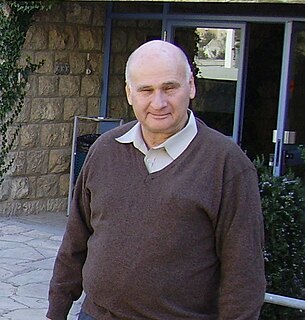In mathematical set theory, the Sacks property holds between two models of Zermelo–Fraenkel set theory if they are not "too dissimilar" in the following sense.
In mathematics, model theory is the study of classes of mathematical structures from the perspective of mathematical logic. The objects of study are models of theories in a formal language. A set of sentences in a formal language is one of the components that form a theory. A model of a theory is a structure that satisfies the sentences of that theory.
In set theory, Zermelo–Fraenkel set theory, named after mathematicians Ernst Zermelo and Abraham Fraenkel, is an axiomatic system that was proposed in the early twentieth century in order to formulate a theory of sets free of paradoxes such as Russell's paradox. Today, Zermelo–Fraenkel set theory with the historically controversial axiom of choice (AC) included is the standard form of axiomatic set theory and as such is the most common foundation of mathematics. Zermelo–Fraenkel set theory with the axiom of choice included is abbreviated ZFC, where C stands for "choice", and ZF refers to the axioms of Zermelo–Fraenkel set theory with the axiom of choice excluded.
For and transitive models of set theory, is said to have the Sacks property over if and only if for every function mapping to such that diverges to infinity, and every function mapping to there is a tree such that for every the level of has cardinality at most and is a branch of . [1]
In set theory, a tree is a partially ordered set (T, <) such that for each t ∈ T, the set {s ∈ T : s < t} is well-ordered by the relation <. Frequently trees are assumed to have only one root, as the typical questions investigated in this field are easily reduced to questions about single-rooted trees.
The Sacks property is used to control the value of certain cardinal invariants in forcing arguments. It is named for Gerald Enoch Sacks.
Gerald Enoch Sacks is a logician who holds a joint appointment at Harvard University as a professor of mathematical logic and the Massachusetts Institute of Technology as a professor emeritus. His most important contributions have been in recursion theory. Named after him is Sacks forcing, a forcing notion based on perfect sets and the Sacks Density Theorem, which asserts that the partial order of the recursively enumerable Turing degrees is dense.
A forcing notion is said to have the Sacks property if and only if the forcing extension has the Sacks property over the ground model. Examples include Sacks forcing and Silver forcing.
In the mathematical discipline of set theory, forcing is a technique for proving consistency and independence results. It was first used by Paul Cohen in 1963, to prove the independence of the axiom of choice and the continuum hypothesis from Zermelo–Fraenkel set theory.
Shelah proved that when proper forcings with the Sacks property are iterated using countable supports, the resulting forcing notion will have the Sacks property as well. [2] [3]

Saharon Shelah is an Israeli mathematician. He is a professor of mathematics at the Hebrew University of Jerusalem and Rutgers University in New Jersey.
In mathematics, iterated forcing is a method for constructing models of set theory by repeating Cohen's forcing method a transfinite number of times. Iterated forcing was introduced by Solovay and Tennenbaum (1971) in their construction of a model of set theory with no Suslin tree. They also showed that iterated forcing can construct models where Martin's axiom holds and the continuum is any given regular cardinal.
The Sacks property is equivalent to the conjunction of the Laver property and the -bounding property.
In mathematical set theory, the Laver property holds between two models if they are not "too dissimilar", in the following sense.














